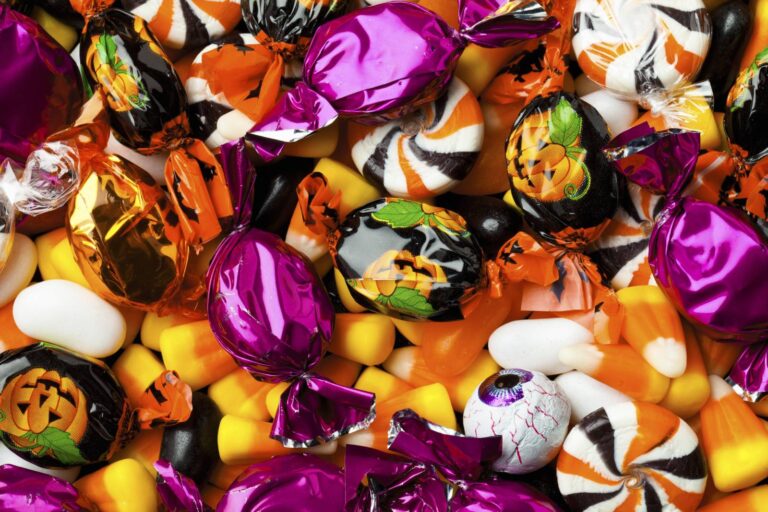Halloween night in Grandville and Holland means neighborhoods full of costumed kids, porch lights on, and pillowcases that get heavier with every house. By the time trick-or-treating wraps up at 8pm on October 31st, your child will have collected pounds of candy. Some of it is perfectly safe for braces. Some of it will destroy brackets faster than you can say “emergency orthodontic appointment.”
Dr. Porto sees a predictable spike in broken brackets and popped-off wires during the first week of November. Parents call our Grandville and Holland offices saying the same thing: “We tried to be careful, but…” The good news is that Halloween and braces can coexist peacefully if you know which candies are safe and which ones belong in the “absolutely not” pile.
The Candy Sorting System
When your child dumps their trick-or-treat haul on the living room floor, institute a three-pile system before anyone starts eating anything.
Pile 1: Safe for braces – These candies can be eaten without worry. Your child can enjoy them throughout the next few weeks as long as they’re brushing and flossing properly afterward.
Pile 2: Maybe okay with caution – These candies aren’t ideal, but won’t necessarily cause problems if eaten carefully and in moderation.
Pile 3: Absolutely not – These candies are bracket-breakers and wire-poppers. They need to leave your house through trading, donation, or the trash can.
Making this sorting activity a family tradition takes the sting out of having to give up certain candies. Some families let kids trade pile three candies for small amounts of money, toys, or privileges. Others donate unsafe candy to organizations that send treats to military members overseas.
The Green Light Candies
These are the candies that make Dr. Porto happy when kids tell him what they ate over Halloween.
Chocolate bars without additions:
- Hershey’s bars
- Plain milk chocolate
- Dark chocolate bars
- Three Musketeers
- Milky Way (the soft kind)
Peanut butter cups:
- Reese’s cups (regular size)
- Peanut butter pumpkins
Soft candy:
- York Peppermint Patties
- Junior Mints
- Peppermint patties in general
Other safe options:
- Plain M&Ms (not peanut or pretzel varieties)
- Kit Kats (break them along the sections, don’t bite through)
- Cookies without nuts or hard add-ins
The key with all safe candies is portion control and timing. Eating three chocolate bars in one sitting and then not brushing creates different problems than bracket damage, namely cavities. Encourage your child to enjoy candy in reasonable amounts and always brush afterward.
The Yellow Light Candies
These candies aren’t automatically off-limits, but they require care and awareness.
Proceed with caution:
- Smarties (can be hard, but dissolve if you let them)
- Sweet Tarts (same issue as Smarties)
- Milky Way Midnight (slightly firmer than regular Milky Way)
- Snickers fun-size bars (soft caramel plus peanuts make this risky)
- Baby Ruth (similar concerns)
The problem with yellow light candies is that kids often don’t exercise the caution they need. They bite down hard on Smarties instead of letting them dissolve. They chomp through a Snickers bar instead of nibbling carefully around the peanuts. If your child tends to be impulsive with eating, treat yellow light candies like red light candies.
The Red Light Candies
These are the candies that cause Dr. Porto to schedule emergency appointments every November. If these end up in your child’s trick-or-treat bag, remove them immediately.
Sticky nightmares:
- Caramels (including Milk Duds and Rolos)
- Taffy
- Tootsie Rolls
- Starbursts
- Skittles
- Airheads
- Now and Laters
- Gummy bears and gummy anything
- Licorice (black or red)
Sticky candy adheres to brackets and pulls them right off the teeth. Even worse, it can get stuck under wires and between brackets where brushing can’t reach it, creating perfect conditions for cavities. There’s no amount of caution that makes sticky candy safe for braces.
Hard candy problems:
- Jawbreakers
- Jolly Ranchers
- Blow Pops and lollipops
- Candy corn (technically belongs in the sticky category too)
- Nerds
- Gobstoppers
- Butterscotch candies
- Life Savers
The temptation with hard candy is to bite down and crunch it. One wrong bite on a Jolly Rancher can crack a bracket or bend a wire. Even if your child has the patience to let hard candy dissolve slowly, it bathes teeth in sugar for extended periods, increasing cavity risk.
Combination disasters:
- Popcorn balls (hard kernels plus sticky caramel)
- Candy apples
- Caramel apples
- Anything with nuts mixed into caramel or nougat
- Almond Joy and Mounds bars
- PayDay bars
- Peanut M&Ms and Peanut Butter M&Ms
These combine multiple problems into one candy. Hard plus sticky, or nuts plus caramel, create compound risks. They’re not worth it.
What About Sour Candy?
Sour candy presents a different problem than sticky or hard candy. Sour Patch Kids, sour gummy worms, and Warheads won’t necessarily break brackets, but the high acid content can damage tooth enamel, especially around brackets where thorough cleaning is harder. Kids with braces should limit sour candy, not because of bracket concerns, but because of the enamel erosion risk.
If your child eats sour candy, have them rinse their mouth with water immediately afterward. Don’t brush right away because the acid temporarily softens enamel, and brushing can damage it further. Wait about 30 minutes, then brush normally.
The Chocolate Strategy
Notice that chocolate dominates the safe candy list. This isn’t an accident. Chocolate melts at body temperature, which means it doesn’t stick to brackets the way caramel or taffy does. It’s also softer than hard candy, so there’s less risk of breaking brackets through biting.
Encourage your child to gravitate toward chocolate options when choosing from their Halloween haul. Most kids don’t need much encouragement here since chocolate tends to be the most popular candy anyway. The bonus is that parents can “tax” their child’s chocolate collection without feeling guilty since it’s the safe option.
The Trading Economy
Many neighborhoods, schools, and communities now have Halloween candy trading or buyback programs. Dentist offices, orthodontist offices, and some businesses will trade candy for small amounts of cash, toys, or coupons. Some programs donate collected candy to troops overseas or to organizations that distribute it to nursing homes.
Check if any businesses in Grandville or Holland are running candy buyback programs this year. These programs turn unsafe candy into something valuable while reducing the temptation to eat it. Your child gets cash or prizes, someone else benefits from the donated candy, and you don’t have to be the bad guy who threw away their hard-earned trick-or-treat haul.
The Sibling Trade System
If you have multiple children and only some of them have braces, institute a trading system. The child with braces trades their sticky and hard candies to siblings in exchange for extra chocolate or safe candies. This feels fairer than just losing candy to the trash can and teaches negotiation skills.
Set clear trading ratios before Halloween night to prevent arguments. Maybe one caramel is worth one chocolate bar, or three pieces of hard candy equal one peanut butter cup. Let kids work out the details with your oversight.
Timeline for Candy Consumption
Don’t let Halloween candy consumption drag on for months. Set a reasonable timeline for finishing the safe candy, maybe two to three weeks. This reduces the constant sugar exposure that leads to cavities and gets the candy out of the house before Thanksgiving brings its own treat challenges.
Some families institute a “candy fairy” tradition where, after a week or two, remaining candy gets collected by a magical fairy who leaves a small toy or book in exchange. This works especially well with younger kids who are disappointed about giving up sticky candies but respond well to imaginative solutions.
Emergency Preparedness
Despite best efforts, brackets sometimes break on Halloween night. Maybe a piece of candy was harder than expected. Maybe your child got caught up in the excitement and forgot to be careful. Maybe a younger sibling shared their Skittles without realizing it was a problem.
Keep orthodontic wax accessible on Halloween night. If a bracket breaks or a wire pops out, apply wax to prevent irritation until you can call our office. Most bracket repairs are quick fixes, but they do require a trip to the orthodontist.
Don’t wait until the following week to address broken brackets. Call our Grandville or Holland office on the next business day to schedule a repair. The longer a broken bracket goes unfixed, the more it can set back treatment progress.
The Brushing Non-Negotiable
Halloween night, brushing and flossing is absolutely mandatory, even if your child is exhausted from trick-or-treating. Sugar sitting around brackets overnight creates the perfect environment for bacteria and cavities. Make this a firm rule with no exceptions.
Consider brushing after the candy sorting activity and then allowing a few more pieces of safe candy before bed, followed by a quick second brush. This reduces the total sugar exposure time while still letting your child enjoy their haul.
If your child attends Halloween parties or events throughout the day on the 31st, pack a travel toothbrush and have them brush between activities if possible. At minimum, they should rinse with water after eating candy.
The Perspective Talk
Before Halloween arrives, have a conversation with your child about the big picture. Halloween happens once a year and lasts one night. Orthodontic treatment represents months or years of effort toward a smile they’ll have for life. Missing out on Starbursts and caramel during one Halloween season doesn’t actually diminish the fun of dressing up, trick-or-treating, and celebrating with friends.
Most kids understand this logic when it’s presented calmly and reasonably. They might be disappointed about specific candies, but they’re not devastated when they know the reasoning and feel included in the decision-making process through candy sorting and trading.
The Day After Reality
November 1st is when reality sets in. Your child has a massive pile of candy, and they want to eat it all immediately. Set clear rules about daily candy portions. Maybe they can have two pieces after lunch and two pieces after dinner, or whatever limit makes sense for your family.
Store the candy somewhere accessible enough that your child doesn’t feel like you’re hoarding it, but not so accessible that they’re constantly snacking on it throughout the day. Frequent sugar exposure is worse for teeth than eating several pieces at once and then brushing.
Looking Ahead
If this is your child’s first Halloween with braces, the candy restrictions might feel disappointing. Remind them that next Halloween might look different. Many kids complete orthodontic treatment within 18-24 months, which means next October could come with the freedom to eat whatever candy they want.
In the meantime, focus on what they can have rather than what they can’t. A pile of chocolate bars and peanut butter cups is still a pretty good Halloween haul by any measure.
Questions about specific Halloween candies? Need to schedule a post-Halloween bracket repair? Contact Enjoy Orthodontics in Grandville or Holland. We’re here to help your family navigate the holiday successfully.





